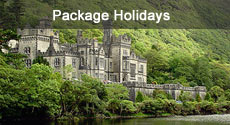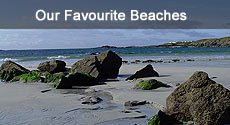Connemara Beaches
Connemara is justifiably famous for its beaches – vast stretches of sand, where often the only footprints are those of various seabirds or the occasional otter. The Renvyle area is particularly blessed with wild, wave-washed strands overlooking the Atlantic ocean and offshore islands – a landscape that has inspired painters, poets, writers and film directors, including such luminaries as Oliver St John Gogarty, Oscar Wilde, W B Yeats and Augustus John.
RENVYLE BEACHES
Only a short drive from the hotel, the Renvyle area beaches are among the finest in Connemara. Among the best known are the spectacular White Strand, a seemingly endless expanse of white sand with its stunning backdrop of mountains, stretching into neighbouring County Mayo; Glassilaun, with a pristine beauty that has featured in a number of films, including Tristan and Isolde, directed by Kevin Reynolds; Lettergesh, one of the locations of the renowned film The Quiet Man, starring John Wayne, and Tully Beach (Tra na mBan). For those who are prepared to do further exploring, there are also smaller coves dotted along the coastline.
Sand-dunes topped by stabilising marram grass are a feature of a number of the beaches; others are fringed with rocks, where marine life, such as sea anemones, sea urchins, shrimps and crabs can be observed close up in tidal rock pools. There are also beaches composed almost entirely of pebbles, and while these may not be as easy on the feet, they are home to a number of interesting plant and bird species.
In addition to spectacular views of mountains, offshore islands and the Mayo coast, the beaches offer many hours of pleasure to those who are interested in natural history. Whilst Connemara’s exposed shores do not play host to the vast numbers of avian winter visitors found on the east and south coasts of Ireland, there are some interesting species that may be observed.
DOG’S BAY and GURTEEN BAY
Situated only a few kilometres from the fishing village of Roundstone, the back-to back beaches of Dog’s Bay and Gurteen (Goirtín, meaning small field) are not only of great scenic beauty, but also of international importance for a number of reasons.
A small, granite ‘island’ known as a tombolo is linked to the mainland by a sandy spit, on the west side of which lies the crescent-shaped Dog’s Bay beach, while on the east is Gurteen beach. Water currents in the area have washed up the calcium carbonate shells of minute, single-celled marine animals from deeper water into the channel between the island and the mainland. Over time the accumulation of these shells has formed the tombolo. The white sand of Dog’s Bay beach is also formed from the remains of these microscopic animals known as foraminifera. Such beaches are rare and the only other example thought to exist in Ireland is in county Donegal.
There are several habitats of interest on the promontory, namely sandy beaches, sand dunes and machair grasslands. The latter are found on lime-rich soils derived from shell fragments, which provide a base for an abundant variety of plant species.Among these are common bird’s-foot-trefoil, white clover, lady’s bedstraw, daisy and red fescue. Vegetation on the sand dunes include marram grass, sea holly, b
iting stonecrop, common bird’s-foot-trefoil and sand sedge.
Typical bird species associated with the type of coastal grasslands seen at Dog’s Bay are ringed plovers, lapwing, common sandpipers and snipe. Although dunlin are rather uncommon along the Connemara coast, small numbers are known to breed on machair grassland. Rabbits are common and cause considerable erosion due to their intensive grazing. One of the rabbit’s main predators is the stoat, which is also seen quite frequently in the region of Dog’s Bay. Among the butterflies that have been observed at Dog’s Bay is the small blue, a limestone species not usually associated with Connemara.
This very special coastal system is threatened by natural sand dune erosion, combined with over-grazing by domestic livestock and rabbits, as well as intensive visitor pressure during the summer months. Visitors are requested to respect the efforts being made to stem the erosion, including the restriction of access to the dunes.


